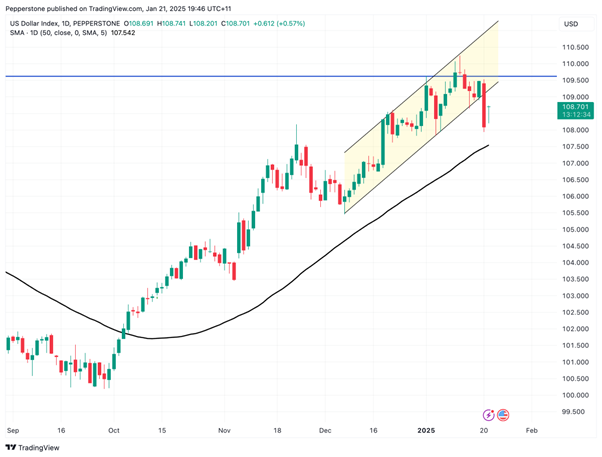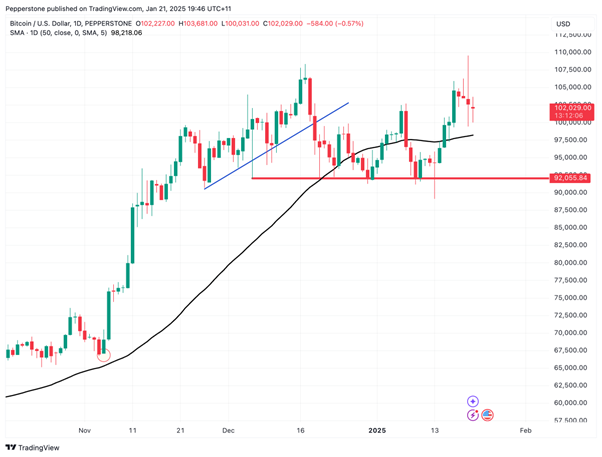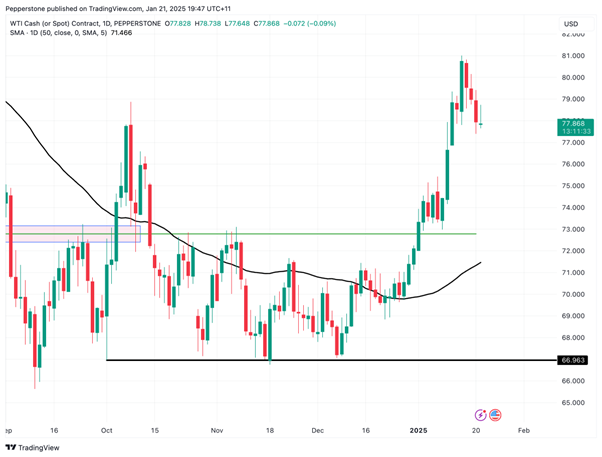CFDs are complex instruments and come with a high risk of losing money rapidly due to leverage. 80% of retail investor accounts lose money when trading CFDs with this provider. You should consider whether you understand how CFDs work and whether you can afford to take the high risk of losing your money.
- English
- 简体中文
- 繁体中文
- ไทย
- Tiếng Việt
- Español
- Português
- لغة عربية
Market volatility, USD decline, and Bitcoin reaction following inauguration
.jpg)
This triggered market speculation that tariffs might be delayed, pressuring the dollar downward. Furthermore, his remarks about cutting tax incentives and taxing foreign companies operating in the U.S. further weighed on dollar sentiment. Contrary to expectations, the dollar tumbled, while cryptocurrencies, which were also notably absent from his address, faced a pullback.

Looking ahead, I believe both assets could stabilize in the first quarter. For the dollar, uncertainties surrounding tariff policies and potential trade frictions are likely to bolster its safe-haven appeal. Meanwhile, resilient U.S. economic data could slow the Fed’s rate-cutting cycle, providing a degree of support.

As for Bitcoin, while the Trump couple’s recent token issuance suggests support for the crypto industry, sharp price swings in recent days have stoked caution. Until regulatory policies and supportive measures become clearer, Bitcoin traders may remain on the sidelines.
In contrast, U.S. equities have responded more optimistically. Trump’s plans for deregulation and tax cuts have the potential to boost sectors like banking, technology, and small to medium-sized businesses. That said, trade policy uncertainty remains a significant headwind. Broad tariffs—ranging from 10% to 20%—could squeeze profit margins for import-reliant sectors such as consumer electronics, auto manufacturing, and retail. While inflation appears contained now, higher tariffs could pass through to consumer prices, potentially reigniting inflationary pressures. This, in turn, might slow the pace of Fed rate cuts, which would weigh on equities.

Gold continues to benefit from safe-haven demand, maintaining its upward trajectory. Meanwhile, Trump’s declaration of a national energy emergency, combined with his push for energy independence, has placed downward pressure on crude oil prices. Should his policies make the U.S. a net energy exporter, global oil prices could face prolonged suppression. Conversely, any measures to restore export levels or secure trade agreements with key producers could lift prices.
In the short term, I expect Trump’s initial executive orders to trigger a period of adjustment and cautious positioning across markets. Over the next 48 hours, as more policy details emerge, markets will gain a clearer picture of the long-term impacts of his agenda—particularly on the U.S. economy and global trade dynamics. These developments could pave the way for continued volatility as traders assess the balance between growth prospects and policy risks.
The material provided here has not been prepared in accordance with legal requirements designed to promote the independence of investment research and as such is considered to be a marketing communication. Whilst it is not subject to any prohibition on dealing ahead of the dissemination of investment research we will not seek to take any advantage before providing it to our clients.
Pepperstone doesn’t represent that the material provided here is accurate, current or complete, and therefore shouldn’t be relied upon as such. The information, whether from a third party or not, isn’t to be considered as a recommendation; or an offer to buy or sell; or the solicitation of an offer to buy or sell any security, financial product or instrument; or to participate in any particular trading strategy. It does not take into account readers’ financial situation or investment objectives. We advise any readers of this content to seek their own advice. Without the approval of Pepperstone, reproduction or redistribution of this information isn’t permitted.